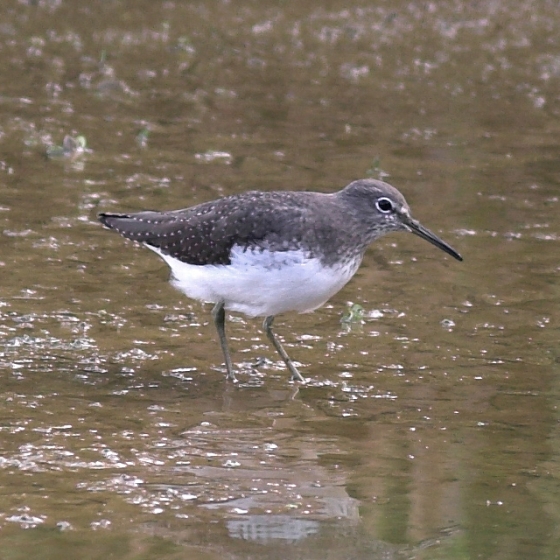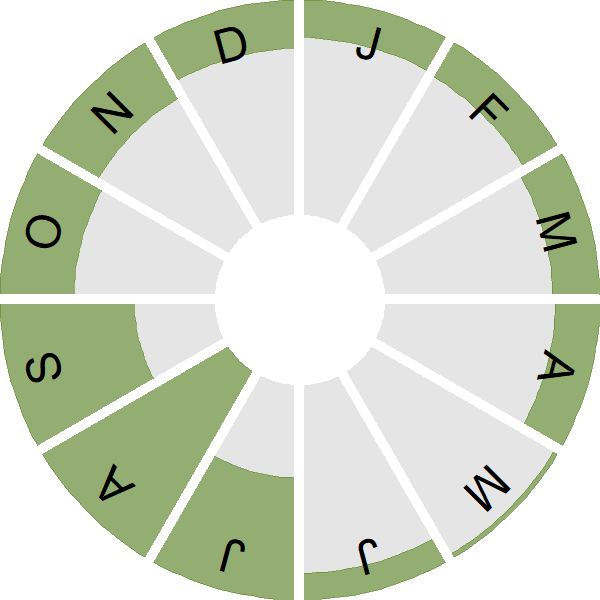Green Sandpiper

Introduction
Most Green Sandpipers are seen during their autumn migration, when they are passing through Britain on journeys from Scandinavia to their African wintering grounds.
They enjoy the clear chalk waters of south-east England, often using old water-cress beds or small ditches, and it is here that a few individuals may choose to spend the winter instead of moving south. An encounter with a Green Sandpiper is often a fleeting view of a dark bird with a white rump, dashing away and making a thin repeated whistle.
Very small numbers of Green Sandpipers breed in northern Scotland, using habitats similar to the tundra more typically used further north.

Key Stats
Identification
ID Videos
This section features BTO training videos headlining this species, or featuring it as a potential confusion species.
Wood and Green Sandpipers
Songs and Calls
Call:
Flight call:
Status and Trends
Conservation Status
Population Change
Green Sandpiper is a very rare breeding bird in the UK, with a small number of breeding attempts recorded from Scotland each year; although few in number, there has been a strong increase over the past 20 years Eaton and the Rare Breeding Birds Panel 2024]. Outside of the breeding season, Green Sandpipers are seen in good numbers between July and September as they pass through on autumn migration and many are present throughout the winter in lowland areas of England and Wales [Balmer et al. 2013]. [WeBS data show an increase in numbers wintering here since the mid 1980s, with numbers having remained relatively stable (although fluctuating) in recent years.
Distribution
During the winter, Green Sandpipers are widely spread throughout much of lowland England with densities greatest in coastal lowlands, major vales and river valleys. Green Sandpipers are very rare breeders in Britain, with three pairs breeding in Scotland during 2008–11.
Occupied 10-km squares in UK
or view it on Bird Atlas Mapstore.
or view it on Bird Atlas Mapstore.
European Distribution Map
Distribution Change
Perhaps as a result of recent milder winters, the number of Green Sandpipers overwintering appears to have increased, with 56% more 10-km squares occupied during 2007–11 compared to in the 1980s. Most gains have been in the lowlands of England, Wales and southern Ireland, though there has also been a notable extension of the winter range into north England and central Scotland.
Change in occupied 10-km squares in the UK
or view it on Bird Atlas Mapstore.
or view it on Bird Atlas Mapstore.
Seasonality
Green Sandpiper is a regular wintering species and very common autumn passage, with first birds arriving in June.
Weekly pattern of occurrence
The graph shows when the species is present in the UK, with taller bars indicating a higher likelihood of encountering the species in appropriate regions and habitats.

Movement
Britain & Ireland movement
Foreign locations of birds ringed or recovered in Britain & Ireland
Dots show the foreign destinations of birds ringed in Britain & Ireland, and the origins of birds ringed overseas that were subsequently recaptured, resighted or found dead in Britain & Ireland. Dot colours indicate the time of year that the species was present at the location.
- Winter (Nov-Feb)
- Spring (Mar-Apr)
- Summer (May-Jul)
- Autumn (Aug-Oct)

European movements
EuroBirdPortal uses birdwatcher's records, such as those logged in BirdTrack to map the flows of birds as they arrive and depart Europe. See maps for this species here.
The Eurasian-African Migration Atlas shows movements of individual birds ringed or recovered in Europe. See maps for this species here.
Biology
Productivity and Nesting
Nesting timing
Egg measurements
Clutch Size
Survival and Longevity
Survival is shown as the proportion of birds surviving from one year to the next and is derived from bird ringing data. It can also be used to estimate how long birds typically live.
View number ringed each year in the Online Ringing Report.
lifespan
Biometrics
Wing length and body weights are from live birds (source).
Wing length
Body weight
Ring Size
Classification, names and codes
Classification and Codes
- Order: Charadriiformes
- Family: Scolopacidae
- Scientific name: Tringa ochropus
- Authority: Linnaeus, 1758
- BTO 2-letter code: GE
- BTO 5-letter code: GRESA
- Euring code number: 5530
Alternate species names
- Catalan: xivita comuna
- Czech: vodouš kropenatý
- Danish: Svaleklire
- Dutch: Witgat
- Estonian: metstilder
- Finnish: metsäviklo
- French: Chevalier cul-blanc
- Gaelic: Luatharan-uaine
- German: Waldwasserläufer
- Hungarian: erdei cankó
- Icelandic: Trjástelkur
- Irish: Gobadán Glas
- Italian: Piro piro culbianco
- Latvian: meža tilbite, titilbis
- Lithuanian: brastinis tilvikas
- Norwegian: Skogsnipe
- Polish: samotnik
- Portuguese: maçarico-bique-bique
- Slovak: kalužiak perlavý
- Slovenian: pikasti martinec
- Spanish: Andarríos grande
- Swedish: skogssnäppa
- Welsh: Pibydd Gwyrdd
Research
Causes of Change and Solutions
Causes of change
The drivers of the increase in the both the breeding and non-breeding populations of Green Sandpiper are unclear.

